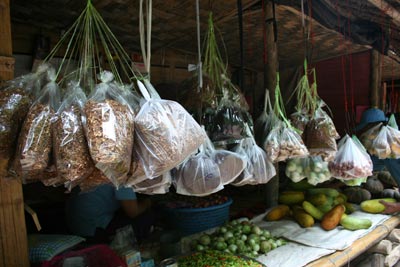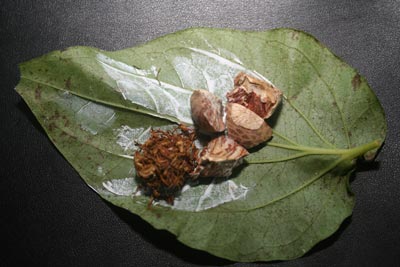- Feature Editor
KARENNI URGED TO CONSIDER HEALTH RISKS OF BETEL NUT
Mae Hong Son: During a recent conversation with a foreigner, a Karenni man excused himself and politely turned away from his guest. He spit a large gob of reddish goo on the ground behind where the two were seated. The foreigner immediately became alarmed and suggested they quickly go to the hospital because the man was coughing up blood!
The guest was not aware he was simply doing what many Karenni and some members of many Burmese ethnic peoples have done for hundreds, if not thousands of years during their history.
The red gooey spit is the product of chewing a dried nut called betel nut, which has been wrapped in a raw green leaf coated with a white paste made from crushed limestone. A gob of tobacco is added to the concoction; or perhaps a smidge of coconut or sugarcane, just to add sweetness.
Tastes vary from person to person, so the list of ingredients varies wildly. And, chewers often change their preferences over time.
It is reported that archeological evidence shows the areca nut and the betel leaf were combined to form one perception altering drug as long as four thousand years ago.
Some even argue the tradition began in Burma and then spread to India and across South West and South East Asia.
 Even today, visitors to Burmese communities inside Burma, or in India, Thailand, Bangladesh- or wherever Burmese migrants live in the world- are greeted several times a day by that infamous red toothed grin and have to step carefully through a trail of reddish goo, as though walking through a minefield.
Even today, visitors to Burmese communities inside Burma, or in India, Thailand, Bangladesh- or wherever Burmese migrants live in the world- are greeted several times a day by that infamous red toothed grin and have to step carefully through a trail of reddish goo, as though walking through a minefield.
Karenni refugee Camp #1 is typical in that most shops sell various combinations of the ingredients for a good chew.
You can stop in to buy your betel nut, green leaves, tobacco, limestone paste and coconut at the same time you buy your onions, noodles, fish paste and other food products.
Several vendors will even customize the mixture according to your own recipe while you wait, to suit your individual tastes.
Shopkeepers purchase their supply of nuts from importers who have purchased them from growers mostly in Burma and Thailand. These importers also supply the various kinds of tobacco used in the process.
Many regular chewers grow their own green plants to supply the leaves they chew.
Some grind their own limestone to make paste; but most buy it.
The profit from selling betel nut products doesn’t seem to be making anybody in the camp rich. It’s more of a sideline.
Shopkeeper, Ba Aye, said in an interview he sells the nut to make a little extra money for his shop next to his home.
Another shopkeeper said most customers are males over thirty.
But, many critics of the practice say young men and women turn to the betel nut as an alternative to drinking and smoking. Many follow the example of their parents, grandparents and friends. The critics say the ingredients needed are too accessible to curious young people.
Forty-five year old, Shay Reh, has been chewing betel nut for more than 25 years. While digging in a ditch near the road, he said in an interview he watched his parents and friends as a young man and began chewing occasionally.
 But, overtime he has become an “everyday chewer”.
But, overtime he has become an “everyday chewer”.
“It’s easy to get and affordable,” he said. “I can get it anywhere.”
During the interview he pulled a chew from his traditional red Karenni bag, hanging on a nearby post.
“I tried to stop once,” he said. “But, I became very irritable, almost in tears. So, I started chewing again.”
While at least one chewer we spoke to insists he can stop whenever he wants, twenty-seven year old Bo Reh agrees with those who say the addictive powers of the betel nut are hard to overcome.
“My mother told me not to smoke or drink, so I started to chew betel nut instead,” he said, adding another chew to the one already in his mouth.
“That is why I still chew today and cannot stop.”
However, to shop owner Ba Aye it’s just about business.
“I don’t know if it affects health,” he said. “I’m doing it for the money.”
But, camp health officials insist there is no question the practice is responsible for serious health problems.
Medical Officer Nye Reh, of the camp’s clinic said in an interview the limestone in the chew is known to damage the gums, chip teeth and cause tooth decay, as well as causing tissue damage in the mouth and throat. He said chewing can cause a B1 vitamin deficiency that affects the sense of touch by causing nerve damage and can cause digestive problems and urinary blockage.
 He also said the practice of adding the nut to rice can cause blood disease and frying it for meals can cause increased heart rate.
He also said the practice of adding the nut to rice can cause blood disease and frying it for meals can cause increased heart rate.
And, he noted four people in the camp are presently suffering from urinary disease and three residents have throat cancer caused by chewing the betel nut.
“I advise those who have not tried the betel nut, not to do so,” he said. “And those who have tried should stop before they become addicted. You won’t want to stop once you do become addicted.”
That is the case for camp resident Plyar Mar Du. She was diagnosed with kidney stones in 1997, after chewing occasionally. The 46 year old said in an interview she did not stop chewing despite her doctor’s warnings. She said she has since developed a urinary blockage.
“I believe my health problems have gotten worse because of chewing betel nut,” she said.
She was chewing at the time of the interview.
Long time chewer Shay Rey gives the same advice to those curious about chewing the betel nut as the camp medical officer.
“We’re old and can’t stop,” he said. “It would be better for younger people to not even start.”


